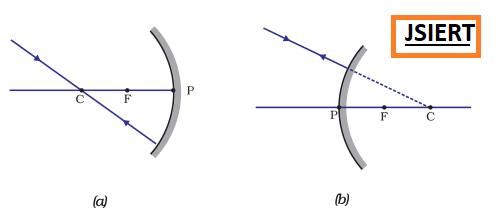The intersection of at least two reflected rays gives the position of image the of the point object. Any two of the following rays can be considered for locating the image.
(i) A ray parallel to the principal axis, after reflection, will pass through the principal focus in case the of a concave mirror or appear to diverge from the principal focus in the case of a convex mirror.

(ii) A ray passing through the principal focus of a concave mirror or a ray which is directed towards the principal focus of a convex mirror, after reflection, will emerge parallel to the principal axis.

(iii) A ray passing through the centre of curvature of a concave mirror or directed in the direction of the centre of curvature of a convex mirror, after reflection, is reflected along the same path. This is illustrated in Fig (a)
and (b). The light rays come back along the same path because the incident rays fall on the mirror along the normal to the reflecting surface.

(iv) A ray incident obliquely to the principal axis, towards a point P (pole of the mirror), on the concave mirror [Fig. (a)] or a convex mirror [Fig. (b)], is reflected obliquely. The incident and reflected rays follow the laws of reflection
at the point of incidence (point P), making equal angles with the principal axis.

